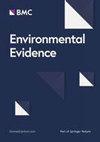Existing evidence on the potential of soils constructed from mineral wastes to support biodiversity: a systematic map
IF 5.2
4区 环境科学与生态学
Q2 ENVIRONMENTAL SCIENCES
引用次数: 0
Abstract
The development of cities and transport infrastructure produces a large volume of mineral waste (e.g. excavated earth material). At the same time, cities are increasingly trying to develop green infrastructures, given the ecosystem services they provide to people, but this comes with considerable economic and environmental costs associated with the transfer of fertile soil from rural areas to cities. In a circular economy approach, the reuse of mineral waste to build fertile soil is a substantial opportunity to reduce the economic and environmental costs of both mineral waste management and green infrastructure development. Soils constructed from these materials (constructed Technosols) must be able to support vegetation growth and become a suitable living environment for soil organisms. This requires ecological engineering to maximise the potential of constructed soils for biodiversity, both from a taxonomic and functional perspective. In this context, we systematically mapped the evidence related to the ability of soils constructed from mineral wastes to support biodiversity. We gathered published and grey literature through searches in two publications databases (Scopus and Web of Science Core Collection), one search engine (Google Scholar), nine organisational websites and through a call for literature. Titles, abstracts, and full-texts were successively screened using eligibility criteria. All included studies were described with coded variables and a database was produced. The extent of evidence was assessed and knowledge clusters and gaps were identified. The searches yielded 9265 articles, and 153 articles were retained after the screening process. More than half of these articles were from European countries, with France leading the field with 40 articles, followed by Spain (15 articles) and Italy (10 articles). Most of the articles (75%) were produced after 2015. The main reasons for constructing soils from mineral waste were for mine rehabilitation (35%), waste recycling (16%) and experimental purpose (15%). The 153 articles were divided into 1962 studies, a study being a combination of a taxon, an intervention (i.e. soil construction) and a measured outcome. Among these studies, the most studied biological group is plants (69% of studies) and especially herbaceous species (32%), followed by microorganisms (17%) and invertebrates (14%). The most used type of mineral waste is mine waste (31% of studies) followed by excavated soil (16%) and demolition waste (14%). Finally, the most frequently measured outcome is plant growth (42% of studies), followed by organism abundance (16%) and diversity (10%). Three main knowledge clusters were identified which could be addressed in the future for full synthesis of the results: (1) How well do plants grow in soils constructed from mineral wastes? (2) What is the potential of soils constructed from mineral wastes to support biodiversity? and (3) How do microbial communities develop in soils constructed from mineral wastes? There is a lack of studies investigating several biological groups at the same time: only 6 articles out of 153 investigated the response of both plants, invertebrates and microorganisms to soil construction. More research is therefore needed on the ability to support a diversity of organisms.利用矿物废料建造的土壤支持生物多样性潜力的现有证据:系统地图
城市和交通基础设施的发展产生了大量的矿物废物(如挖掘出的土方材料)。与此同时,鉴于城市为人类提供的生态系统服务,城市正越来越多地努力发展绿色基础设施,但这也带来了相当大的经济和环境成本,这些成本与肥沃土壤从农村地区转移到城市有关。在循环经济方法中,重新利用矿产废料来建造肥沃土壤是降低矿产废料管理和绿色基础设施发展的经济和环境成本的一个重要机会。用这些材料建造的土壤(建筑技术溶胶)必须能够支持植被生长,并成为土壤生物的适宜生存环境。这就需要进行生态工程设计,从分类学和功能角度最大限度地发挥人造土壤的生物多样性潜力。在此背景下,我们系统地梳理了与利用矿物废料建造的土壤支持生物多样性的能力相关的证据。我们通过两个出版物数据库(Scopus 和 Web of Science Core Collection)、一个搜索引擎(Google Scholar)、九个组织网站以及文献征集活动收集了已发表的文献和灰色文献。根据资格标准对标题、摘要和全文进行了筛选。所有收录的研究都用编码变量进行了描述,并建立了数据库。对证据的范围进行了评估,并确定了知识集群和差距。检索共获得 9265 篇文章,经过筛选后保留了 153 篇文章。这些文章一半以上来自欧洲国家,其中法国以 40 篇文章居首,其次是西班牙(15 篇)和意大利(10 篇)。大部分文章(75%)是 2015 年之后发表的。利用矿物废料建造土壤的主要原因是矿山恢复(35%)、废物回收(16%)和实验目的(15%)。这 153 篇文章被分为 1962 项研究,一项研究由分类群、干预措施(即土壤构建)和测量结果组成。在这些研究中,研究最多的生物类群是植物(69% 的研究),尤其是草本植物(32%),其次是微生物(17%)和无脊椎动物(14%)。使用最多的矿物废料类型是矿山废料(31% 的研究),其次是挖掘出的土壤(16%)和拆除废料(14%)。最后,最常测量的结果是植物生长(42% 的研究),其次是生物丰度(16%)和多样性(10%)。为全面综合研究结果,确定了三个主要知识集群:(1)植物在矿物废料土壤中的生长情况如何?(2) 利用矿物废料建造的土壤支持生物多样性的潜力有多大? (3) 微生物群落如何在利用矿物废料建造的土壤中发展?同时调查多个生物群体的研究并不多见:153 篇文章中只有 6 篇调查了植物、无脊椎动物和微生物对土壤构建的反应。因此,需要对支持生物多样性的能力进行更多的研究。
本文章由计算机程序翻译,如有差异,请以英文原文为准。
求助全文
约1分钟内获得全文
求助全文
来源期刊

Environmental Evidence
Environmental Science-Management, Monitoring, Policy and Law
CiteScore
6.10
自引率
18.20%
发文量
36
审稿时长
17 weeks
期刊介绍:
Environmental Evidence is the journal of the Collaboration for Environmental Evidence (CEE). The Journal facilitates rapid publication of evidence syntheses, in the form of Systematic Reviews and Maps conducted to CEE Guidelines and Standards. We focus on the effectiveness of environmental management interventions and the impact of human activities on the environment. Our scope covers all forms of environmental management and human impacts and therefore spans the natural and social sciences. Subjects include water security, agriculture, food security, forestry, fisheries, natural resource management, biodiversity conservation, climate change, ecosystem services, pollution, invasive species, environment and human wellbeing, sustainable energy use, soil management, environmental legislation, environmental education.
 求助内容:
求助内容: 应助结果提醒方式:
应助结果提醒方式:


